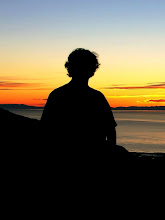Morning. Damp, under slate-gray skies.
An empty bottle of bourbon,
Brimming with missing memories.
Fermenting thoughts roil,
Earl Gray answers the call.
Not the couch: stillness is decay,
Compulsion, the couch.
A book! That's it, a book!
Every page a refuge,
Every sentence a bulwark,
Keeping at bay the waves.
Crashing into the barricades, relentless.
Not so much a pack of hungry jackals,
But a warm blanket of anesthesia.
Despair, how insidious thy hand!
Potent indeed, yet, inadequate.
Music swells, fear-storm abates.
It's daylight again!
